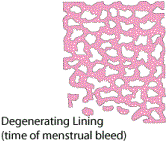|
UTERINE PHASES OF MENSTRUAL CYCLE MENSTRUAL PHASE: The phase of blood flow The changes that occur at the end of earlier phase cause tissue death, which causes blood vessels to open, producing scattered small bleeding points. These enlarge and along with shedding of the overlying endometrium result in menstrual bleeding. In cycles, where ovulation has occurred, shedding of endometrial tissue fragments usually start in patchy fashion about 12 hours after bleeding begins. Ordinarily the shedding is not uniform throughout. About two thirds of the entire endometrium is lost with each ovulatory menstruation. By the time brisk flow stops; most of the tissue has been lost from the inner surface of the uterine cavity. The pattern of menstrual bleeding is quite variable. It ranges from very heavy flow for 12 to 24 hours followed by scanty bleeding during subsequent days in some to an almost uniform flow throughout the period. After 4 to 7 days, bleeding gradually diminishes.
|
